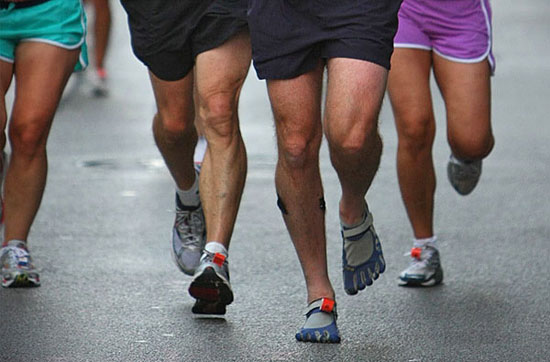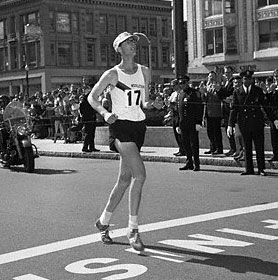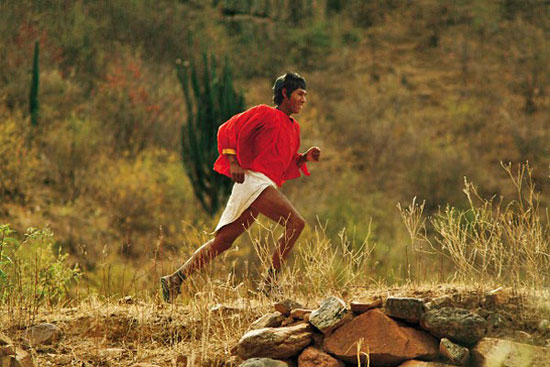A long-running debate
March 6, 2014

A revolution in distance running led some die-hard striders to wear practically nothing on their feet.
Visit the L.A. Marathon’s Facebook page and you’ll find yourself in a world of hurt.
“I start to lose feeling/circulation from my forearms up to my fingers,” one dispirited runner posted last week during a live chat with Dr. Seth Gamradt, director of Orthopedic Athletic Medicine at the Keck Medical Center of USC.
“I have pain when I bend my knee,” reported another would-be marathoner.
“My legs tend to [go] numb after 5 miles,” said yet another, followed by still others who complained of everything from shin splints to sprained ankles to stress fractures.
But ailing bodies weren’t the only concern as the 29th L.A. Marathon approached. One young woman weighed in with a question that has been the great obsession of the running community for the past several years, one that you might say has led to profound sole searching.
The young woman told Dr. Gamradt that she was worried about having “incorrect running form” and wondered whether she should change her style to land first on her forefoot, rather than on her heel. No way, he told her, it would take months for her body to become accustomed to a new foot strike.
“To dramatically change your stride for no reason is asking for trouble,” Gamradt, a triathlete, said the other day as he recalled the woman’s question. “Some people are developing stress fractures and injuries trying to convert to that style… My whole thing is that if you’ve been running well with your traditional foot-strike pattern, then what’s the reason to change?”
You might think that, of all sports, none could be simpler than one in which you simply put one foot in front of the other, even if it is for 26.2 grueling miles. But during the past few years, a revolution has occurred on the streets and in academia that has called into question the very notion of how we should run and what we should put on our feet, if anything.
In other words, there’s a lot more than meets the eye to those wildly-colored kicks you’ll see pounding the pavement during Sunday’s sold-out L.A. Marathon.
None of this is about getting to the finish line faster, the experts say. It’s about trying to sidestep injuries—a never-ending obsession for most runners, especially those who push their bodies to the brink and beyond.
For decades, running shoe companies have tailored their products to this injury-prone crowd, offering pricey shoes that claim to provide extra stability or cushioning, depending on a runner’s foot and gait. But in 2009, Christopher McDougall’s best-selling book, Born to Run, upended the industry’s conventional thinking and marketing machine.
In his book, McDougall chronicled the seemingly superhuman feats of the Tarahumara Indians of Mexico, who can run 100 miles a day across rugged canyons while wearing flimsy sandals assembled from strips of leather and old tire tread. McDougall argued that clunky, heavily-padded modern running shoes encourage people to unnaturally hit the ground first on their heels, sending excessive impact force through their feet and legs, increasing the risk of injuries. McDougall said his study of the Tarahumara Indians showed that, instead, runners should land gently on their forefoot, wearing as little shoe as possible or none at all.
The next year, a widely-publicized Harvard study seemed to back him up, suggesting that forefoot striking strengthens feet, reduces impact and helps runners avoid or mitigate such repetitive stress injuries as plantar fasciitis and “runner’s knee.”
Almost overnight, the era of barefoot running and “minimalist” shoes was born. Shelves in both specialty running stores and mass-market retailers were soon lined with light, flexible shoes that included a lower heel to help facilitate an easier forefoot strike.
Runner’s World writer Scott Douglas says that in 2012, “when minimalism was in its zealot phase,” he began work on a book about the phenomenon. But by the time “The Runner’s World Guide to Minimalism and Barefoot Running” was published last year, Douglas says, “the pendulum had begun to swing back.”
“I wrote it at exactly the wrong time,” says Douglas, a runner of 35 years. He says there’s now actually “a backlash against minimalism” as runners have come to realize that good, injury-free running involves more than shoes. In fact, a study published in January in the British Journal of Sports Medicine found that runners who switched to minimalist shoes, without slowly adapting to them, had two to three times as many injuries.
“It’s simplistic to think that by putting on new shoes, it’ll fix everything,” Douglas says. “Shoe selection is a part of that but certainly not all of it. The winner of the L.A. Marathon would still look amazing in old-style running shoes.”
Amby Burfoot has the long view of all this, having watched fads come and go in the running community for decades. In 1968, he won the Boston Marathon and has returned every five years since to run the world’s most famous race. A light heel-striker himself, he says that the single most important advice he can give runners is to not take overly long strides, which lead to an excessively hard heel strike.
“Most of the shoe cultist people, especially the ‘barefoot people,’ are now changing their tune. It’s not your shoe but your running form and foot strike that makes the difference,” says Burfoot. “The shoe companies, with their hordes of lawyers, are now being very careful about what they say about injuries and performance. They’re appealing to the soul of the runner, the persona of the runner. No one dares say their shoes will prevent running injuries.”
As for that pendulum, Burfoot agrees that it’s now swinging in a new direction. As proof, he says he need look no further than his own brother, who’s had great success lately with a new wave of shoes with “super thick soles.”
Their nickname: “maximalist.”
For Dr. Seth Gamradt’s tips on how to avoid injuries and stay strong for the marathon, click here.
Posted 3/6/14














 405 bridge work causes a stink
405 bridge work causes a stink





